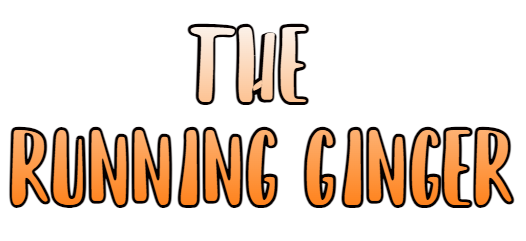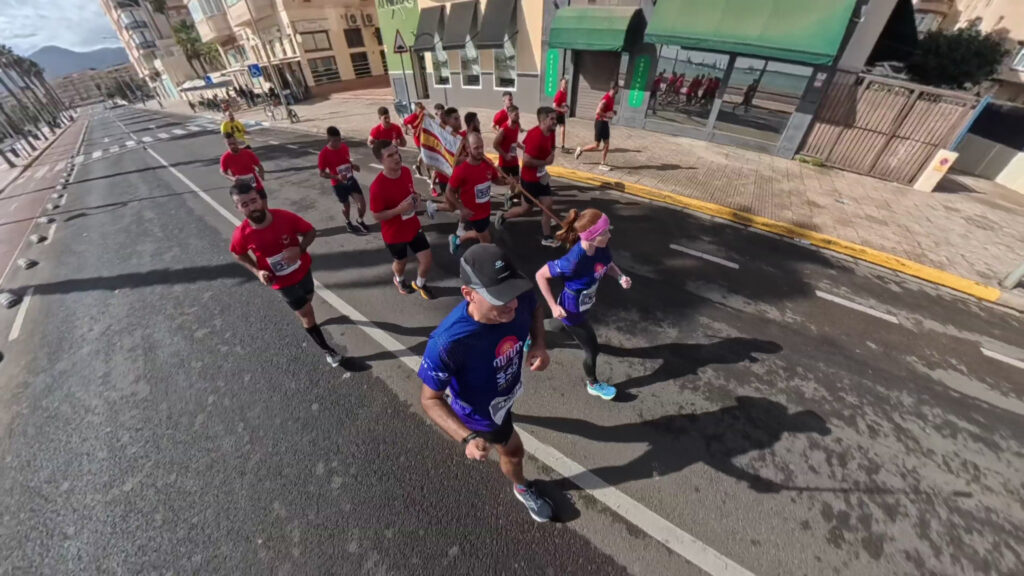Tokyo Marathon. Tokyo, Japan 🗻. 3rd March 2024.
In a harbinger of the coming spring, Tokyo welcomed runners from all around the world. Asia’s biggest marathon took place on a spectacular sunny day with cherry blossoms. We ran through avenues full of advertising billboards, Shinto temples and communication towers that are symbols of progress.
TLDR; “too long, didn’t read”
- I just want to run! Take me to RACE.
- I have 1 minute. Take me to USEFUL INFORMATION.
- Running is my excuse for travelling. Take me to TRIP.
- Running is my excuse for eating. Take me to CARBOLOADING.
- I want to know what to read in the plane. Take me to ONE BOOK or TO KNOW MORE.
Building up 💪
Being a marathon major, it is not easy to gain a spot in the Tokyo marathon. To increase their chances, many runners take part in the virtual runs organised officially, and that even include a “Virtual Tokyo Marathon”.
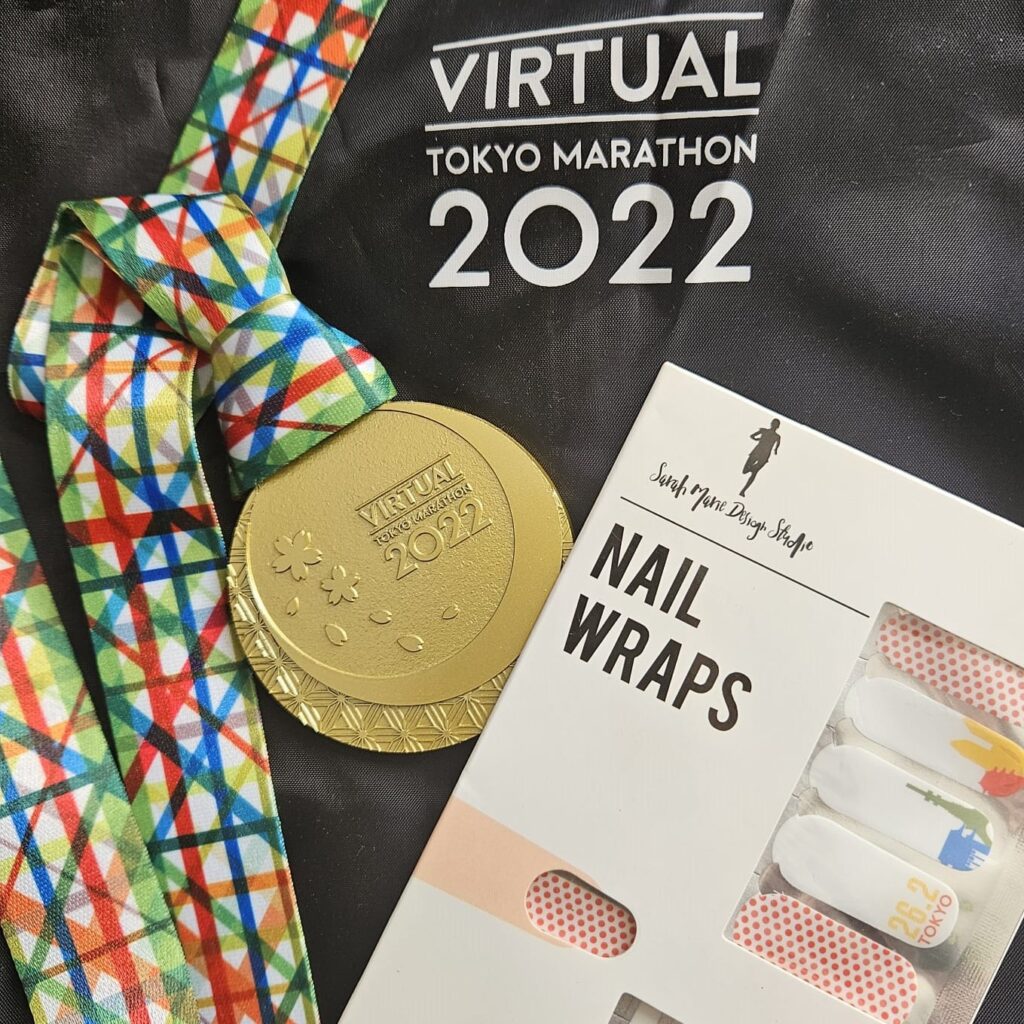
The Virtual Tokyo Marathon is a month-long virtual event in which 100 finishers have the chance to win a guaranteed, non-complimentary entry ticket to the Marathon by random drawing.
I ran the “Virtual Tokyo Marathon” in 2022 and I was so excited about the race, that I even bought a set of nails with the Tokyo logo by Sarah Marie Studio 💅🏻, an online shop for running clothes and accesories.
The nails are shown in the picture above, together with the merchandising I got from completing all runs of 2022 😎.
Pre-trip ⌚
The trip was organised by Spanish agency Fernando Pineda: and very well organised, I might say.
The agency organises every aspect of the trip, and during the weeks before the race keeps you constantly engaged with emails with information.
For instance, we received information about the neighbourhood we were going to stay, the vibrant Shinjuku, and about the hotel itself:

They also organise a couple of webinars a few weeks in advance with the president and CEO, Fernando Pineda himself, our tour guides (Japanese Kimiko and Spaniard Noemí), and former champion Fabián Roncero, who to this day still holds the Spanish record for half marathon and 10k and who collaborates with the agency.
The recording of the webinar (in Spanish and with details about the 2024 edition) can be found here.
The webinar is full with useful information, from the temperature to expect, distances to the start and finish lanes, type of course and even some logistics, including how to move around Tokyo.

Check my entry
“My Entry” is a personal page for all runners entering into Tokyo Marathon 2024 in which you can check your entry status. If you are lucky enough to be selected to run, will show as well the payment, the official goods purchased and similar participant information, including the BIB confirmation, which we printed in PDF to get our goods once in Tokyo.
When finishing, you can check the results and therew will be the issue of your finish certificate! 🤘
Runners Handbook
Every runner also gets a “Runners Handbook” which contains all you need to know. We carefully read about our packets pick up, things to bring on race day, aid and medical station along the way…
I include here the parts that I found most useful:
“No trash cans are available. Please take home any trash that you have with you.”
“Throwing away clothing is prohibited. Please use the Clothing Collection Boxes.”
Times before the race starts:
- 7:00 a.m. Open the Start Gate to enter to the start area
- 8:45 a.m. Deadline for entry at the start area
- 8:55 a.m. The final call to line up at the Start Corral
Distance markers during the race:
- Every 1 km up to 42 km
- 5km to go, 4km to go, 3km to go, 2km to go, 1km to go -> these proved to be the BEST ones ever! 😝
- Every 1 mile and 5 mile point

📅 The Marathon Expo 🎽
We went to the marathon Expo which was taking place in Tokyo’s international convention centre, “Big Sight“, to pick up our “runners kit” on Thursday afternoon.

Some of our fellow runners told the group that there were queues up to 2 hours to pick up your BIB! So, in the bus, some runners almost panicked.
But finally it all turned to be ok: we only queued for a few minutes!

When it was our turn, we found out that we were misgendered 😱. I was registered in the “General-man” category and Roger in the female one. But we went to the Help desk and a very helpful American lady corrected the mistake for us. It all ended up in just a funny anecdote and the wrong category in the results…
Then we got our BIBs checked, and we entered the marathon expo.
We queued in front of the logo for the mandatory picture:

And we even took another picture in front of a mural which had been created by a local artist when the marathon opened. It was all very cool, with the slogan “Tokyo, my favourite place” everywhere.
Then we visited the Asics store and all of the many, many stands that occupied not one but two floors of the “Big Sight Tokyo” and greeted the Tokyo’s metro mascot, who was very energetically cheering on the future runners.

The kit: A super cool t-shirt 👕 and brochures with photo locations 📸!
In the bag we found the official t-shirt. The t-shirt was a great success amongst runners, friends and family (according to the comments I overheard in the expo and received in social media). And for a reason: the design is just so cool:

Special mention also to one of the brochures included in the runner’s bag: the one that listed the locations where the pictures of the marathon were going to be taken!
These included iconic places like Ginza and in front of landmarks like Zojoji, the Tokyo Skytree or the Tokyo Tower:

Also thanks to the brochure, I confirmed what the agency already told us in one email: “You are going to run with the greatest!” 🏅🏅🏅
That is, that many outstanding runners including Eliud Kipchoge were running the marathon as part of “invited elite athletes”. By the way, Spoiler alert: Kipchoge ran in 2h 06m… and he came 10th!
The day after we got to see a few who were staying in our hotel, had breakfast next to Sifan Hassan, and some of our fellow runners from the agency took some selfies with Eliud Kipchoge!
By the way, talking about running legends, I found out (after the race) that one of my running heroes, Joan Benoit Samuelson, who won the first Olympic marathon, ran the race. Read the news here.
Tokyo Marathon Friendship Run 🎌
The Tokyo Marathon Friendship Run is a 5k run to foster relationships between Japanese runners and international runners visiting Japan.
Every year, runners from all over the world run together with costumes and fancy dresses under the slogan “The Day we unite”.
The race started and finish at the Taito City Riverside Sports Center Athletic Field, not far from the Asakusa Kaminarimon Gate, which is part of the Tokyo Marathon course, and took place on a scenic course around Sumida Park, which also offers a view of Tokyo SkyTree.
We didn’t run it because we didn’t want to get too tired; 5kms for us was too long a distance the day before the marathon.
But many people from our agency did go, dressed with costumes, and apparently had a blast!

🌍 The trip 📷: What to see in Tokyo in a few days
Arriving and first impressions: Pre-marathon atmosphere
The trip from Narita Airport to Keio Plaza Hotel in Shinjuku took us almost an hour and a half. It was rush hour after work and the highways were congested. This allowed me to see the frantic office life inside Tokyo’s skyscrappers: as sunlight was fading outside, I could see Japanese white collar workers in meetings or in front of computers. While outside the million lights from shops and ads were fighting for attention.
On Thursday morning we went to have brekfast early. In the elevator, we already ran into super fit Japanese runners dressed head to toe with “Tokyo Marathon” merchandise who were going for an run at 6:30am! Yes! Pre-Marathon atmosphere 100%! 🏃♀️ 🙌 🏃♂️
Keio Hotel is comfortable, but also classy and spacious. But the most important benefit of staying there was the location: walking distance from the starting line.
Hinamatsuri
During our stay, it presented the decoration of Hinamatsuri, the Japanese holiday celebrated on March 3 (yes, the same day of the marathon), known as the girls’ or dolls’ festival 🎎.
It’s a deep-rooted tradition which involves family rituals to wish girls health and good luck. The most notable is to display a set of dolls dressed in classic Japanese clothes, originating from the belief that these figures could scare away evil spirits, thus protecting their owners.
The practice evolved from the Hina Nagashi ceremony of the Heian Period, where paper dolls were sent by boat down a river to expel evil spirits.

The festival includes a traditional song and typical dishes such as Hinaarare, which are small, colorful and sweet rice balls, along with Shirozake, a sweet white sake, consumed to purify the body. Of course, we only got to see the dolls display and we did not taste any sake 😁
Tourism: Tokyo‘s highlights 🗼
Tokyo is a big, big city full of many interesting points not to be missed. One of the slogans of the marathon is “Tokyo, my favourite place”, and well, it is certainly one of mine.
We had a few days before the marathon to visit Japan’s capital. I include here the list of landmarks and attractions we were fortunate to see, and why in my opinion they are worth a visit!
Meiji Shrine
Meiji Shrine is one of the most important Shinto shrines in Tokyo, dedicated to Emperor Meiji and Empress Shoken, who played crucial roles in the modernization of Japan during the Meiji Restoration. It offers insight into Japan’s rich history and cultural heritage.

I really liked it, not only because of it seeting, a serene forested area in the heart of Tokyo, with towering trees, tranquil gardens, and expansive grounds. But also because its architecture is a beautiful example of traditional Japanese design.
It features grand Torii gates, wooden structures, and intricate carvings.

Tokyo Tower 🗼
The Tower is one of the most recognizable symbols of Tokyo, and due to its striking design is often referred to as the city’s Eiffel Tower. In fact, it is so iconic that it has even its own emoji 🗼!!
We ascended to the Main Deck, which is 150 meters high, and we got beautiful sights of Tokyo. Luckily it was a clear day:

And we got to take pictures in its glass floor!

Built in 1958, Tokyo Tower holds historical significance as a symbol of Japan’s post-war recovery and economic prosperity.

Senso-ji is Tokyo’s oldest and most significant Buddhist temple, with a history dating back over 1,300 years. It stands as a symbol of Japan’s rich cultural and religious heritage, attracting millions of visitors each year.

On the day we visited it, there were certainly a lot of people visiting, as can be seen in the pictures:

The temple’s architecture is stunning, characterized by its vibrant red color, intricate wooden carvings, and impressive gateways, including the iconic Kaminarimon Gate with its massive red lantern:

The approach to Senso-ji is lined with bustling Nakamise-dori shopping street, where visitors can browse through a wide array of traditional souvenirs, crafts, and street food. It’s a great place to immerse yourself in Tokyo’s vibrant street culture and sample local delicacies.
Shinjuku
Shinjuku is known for its bustling entertainment district, offering a plethora of options for dining, shopping, and nightlife. From upscale department stores and trendy boutiques to quirky shops and traditional markets, there’s something for everyone’s taste and budget.

It boasts an impressive skyline dominated by towering skyscrapers, including the Tokyo Metropolitan Government Building, which we could see from our hotel room. At night, it is iluminated with colour lights 🤩
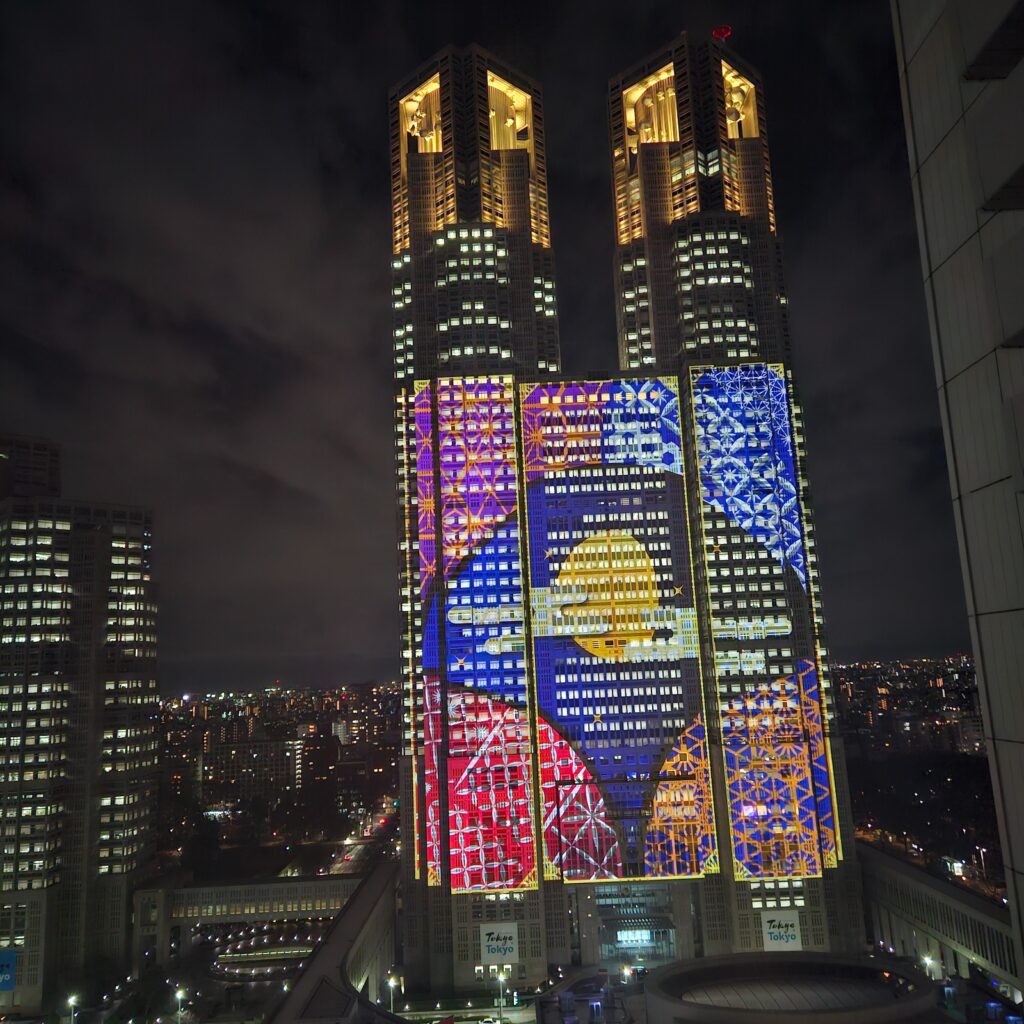
We wandered around its streets (see below a section about the famous Omoide Yokocho), and we got to see the famous 3D Billboard with the cat!
Shibuya
Shibuya Scramble Crossing, often simply referred to as Shibuya Crossing, is one of the most famous and iconic intersections in the world.
We loved it! It wasn’t rush hour; it was 11am. But its bustling, chaotic energy encapsulates the vibrant and fast-paced atmosphere of Tokyo.

We went up seven stories to see it from a rooftop bar, which costed 1500 yens but included a drink. I took a “matcha latte”, which is delicious but very very sweet!

The Imperial Palace
The Imperial Palace serves as the primary residence of the Emperor of Japan and has been the center of Japanese imperial power for centuries.

That is why you cannot enter. But you can see it from the outside, admire its magnficent walls and take pictures of the Nijubashi Bridge, an iconic double-arched bridge which serves as the main entrance to the Imperial Palace:

Steeped in history, the Imperial Palace provides insight into Japan’s long-standing imperial traditions and the country’s rich cultural heritage: do not miss it!
Taira no Masakado Tomb
While we were walking from the Imperial Palace to the Akahaba neighbourhood… when we were in the middle of some of the world’s most expensive land, the Otemachi district… we saw a couple of executives paying tribute to some kind of monument.

It turned out to be the tomb of Taira no Masakado. But, who was he?
He was a samurai warrior and nobleman who lived during the Heian period and led a rebellion against the central government in Kyoto, claiming the title of “Shinno” or “New Emperor” of the Kanto region. His rebellion was ultimately suppressed, and Masakado was executed. And here the legend starts!
It is believed to be haunted, with legends suggesting that Masakado’s vengeful spirit caused calamities in the area. Despite attempts by the government to relocate the tomb and develop the land, superstitions and reverence for Masakado’s memory have led to the preservation of the site.
Tokyo Skytree
Actually, we didn’t go up, but we did see Tokyo’s Skytree from different angles. The tower is 634 meters high, and this number is not random.
When considering the height for a tower that was to be the world’s tallest tower and a symbol for the region, 634m was chosen. The number 634 is an easy number to remember as it can be read as “musashi,” which is a word that is very familiar to the Japanese.
In fact, at home I have a book by a famous samurari who was called Miyamoto Mushashi 😎: “The book of five rings“.
National Jarden Shinjuku-Gyoen
The day before the marathon we did not walk much, but we did go to the “cannot be missed” National Jarden Shinjuku-Gyoen, and we were so lucky… we did see the first cherry blossoming in Tokyo!


🏃♀️ The marathon 🏃♂️
Getting to the start
We were scheduled to meet with our fellow runners from Fernando Pineda’s agency in the lobby at 7:30. And so we did.
We took the traditional picture, next to other groups doing exactly the same:

Everybody was excited and there were a few runners who sported a special dorsal from Abbott World Marathon Majors that readed: “Today is the day… I complete the six Major. Cheer on me!” together with the list of all the majors.

I was excited: for us, it was our 5th major, but, as the finish of this challenge / dream is approaching, I get more and more nervous! 😬
We also chatted with some other runners, and we got to know a young man who was running with his father and who looked extremely fast. And he was! He was planning to finish in 2h 30m! 🏃
Around 8am, we left for the starting line.

It was a cold day, and some of the runners who were dressed with tank topes and shorts were shivering. We were dressed for the cold, even with gloves. But it was also sunny! And that contributed to the cheerful atmosphere.
Perfect organisation
Tokyo’s Marathon is perfectly organised, and you can see that from the start. There were different gates, and different corrals, all marked with different colours.

Our departing time, marked in our BIBs, was 9:10. We were there 45 minutes in advance and we used the time to take pictures of the great location.
The skycrappers were illuminated by the sun; the image reminded me to of Chicago, but with this big difference: in Chicago, the skycrappers were covered by clouds!
The Japan flag was flying in some of the hotels, and we slowly made our way to the start line walking. Above the thousands of runners, there was a bridge with a lot of spectators taking pictures of us, with some flying the Ukranian flag and a couple reading “Free Hong Kong”. Funnily enough, during the race we would see multiple groups of Chinese supporters, very loud and with very, very big China flags.

Around us, the conversations varied: from a fit old lady explaining she was 82, to a couple of american women talking about the start of the Boston marathon.

In a big screen, messages about “How to be a cool runner” 😎. There explained not to throw out waste to the floor, and to use the toilets. We followed to instructions to the letter! And so did the vast majority of the runners, by the way.
Anyway, walking and almost without realising… we saw the start line!

Amongst the skyscrappers, the Japan flags and with the sun as a gift, some “Tokyo” signs and the start line.
Starting off
So, off we went!
Another similarity with Chicago is that, due to the percentage of skyscrappers, our Garmin watches went completely crazy! They marked wrong distances, so we learnt to only guide ourselves with the signs. In fact, when I fnisihed my Garmen marked that I had run 45 kilometers! 😅
The “magnets tragedy”
As the sun continued to shine and the runners started to warm up, we saw a few gloves on the floor. These gloves and later, some Tokyo Marathon magnets that were given with the “runners bag” were the only waste we saw.
By the way, regarding the magnets that were supposed to hold your BIB in place instead of the typical safety pins. They were so cute! But we were skeptical about whether they could hold the BIBs…. so we did a test.
Roger put them in his jacket and violently shaked it. They did not hold.
So we opted to use the typical safety pins, and judging by the number of magnets we saw on the floor, we made the right choice.
First kilometers: Shinjuku
The first kilometers are run through wide avenues with a lot of advertisements in the buildings, the most ‘typical’ Tokyo scenarios. Shinjuku 100%!!!

We had walked these streets the days before so they looked familiar, but at the same time completely different now that thousands of runners were crossing their streets.
When the elevation of the road allowed it, I could see a true “ocean of colours” with all the runners. It was so exciting!
Entering Chidoya
Everybody was civilised and there was a big number of local runners; and, of course this being Japan, a lot of people with costumes! We were passed by a guy dressed as “Super Mario”… with a car included! He was very popular with the spectators.
A band in uniform was playing and people were showing their support with shouts in Japanese.
There was a lot of people cheering, the Japanese way. That is, also with costumes! I remember seeing a middle age man dressed as a red dog, with his face also painted completely in red. It was so funny!
Let’s also mention the aid stations: They served isotonic drinks and water, in this order. Later, they would also offer things to eat. The thing with the aid stations is that they were marked in a way that runners should only go to the area that matched their BIBs.
But, as Roger put it: “They are crazy if they think I will follow this rule!”. Funnily enough, though, some people did.
We drank in all aid stations religiously, as we always do in marathons. The same way we eat our gels at kilometers 10, 20, 28 and 36. When it comes to “not hit the wall”, better safe than sorry! But, as I will describe later, this marathon turned up quite different in the end.

Akihabara
We recognised this neighbourhood, and Roger even mentioned it. This was approximately kilometer 10, and we smiled and waved every time we saw a photo locations. The photo locations were marked, and they started around kilometer 12 📸.
A band of police officers were playing and I had a “Japanese” moment when in front of me I saw a girl with a “Doctor Slump” tshirt and, next to her, a man with a tshirt with Hokkusai’s wave: “the great wave off Kanagawa“.
On our way to Asakusa: The half marathon
We passed the half marathon point still going strong, but we did stop at a toilet for obvious reasons.

And after that, around kilometer 27, my back started playing up and hurting, so when Roger suggested we walked, I decided to stop. We started a trend of walking 1 kilometer and then running 2. It was clear by now that this was not going to be our fastest marathon!
At some point, there was some music played… The march of “A bridge on the River Kwai“. Curious choice…
It was emotionally painful to be walking, but at least we could enjoy the streets, the atmosphere, the buildings… like the beautiful Tomioka Hachi temple.
Kilometers 30 to 40: Ginza and Tokyo Tower
Walking / running from kilometer 30 to kilometer 40 seemed eternal… but my back could not manage more. It was made more difficult by the fact that you run in one direction and then back, so we got to see the runners passing kilometer 39 when we were “still” at kilometer 34.

Still we were enternaited by our fellow runners – some had funny additions to their caps: pikachus, pineapples or Toy Story’s Woody.

A funny anecdote happened when a japanese spectator shouted to three runners. “Go Germany!” mistaking their flag, and the runners shouted back… “We are from Belgium!”. It really made me laugh!
I also enjoyed massively some of the shows that the locals were putting on: like a band of traditional drummers, all very young, who coordinated their music and their silences in such a perfect way that it was very dramatic. Or a group of young girls dancing like a J-pop band.

Finishing near the Imperial Palace: great atmosphere!
Finally we reached kilometer 41, and we got to run quite comfortable the last kilometer.

You turn right and start running in the shadows of skyscrappers; the streets are packed with people shouting and I got very emotional, although I could not cry as I was too tired 😂
The last meters you turn left, leaving the iconic Tokyo’s station at your back; although I did not realise as I could only see the “Finish line” in pink columns.

And finally we made it! We had run 42,195 kilometers around Tokyo.
The medals, the thermic blankets, the poncho!

We got handed the medal by very smiling volunteers and then a very well folded thermic blanket.
I was ecstatic as we had finished, and we watched how some lucky runners had earned their 6th star and were taking themselves pictures with them. Ah… hopefully we will have our own star soon!

But today was the day to celebrate the race we had finished. It was sunny and everybody was tired but happy!
And when we thought we were not going to receive more goodies, we were given a poncho that looked like a bathrobe, with the beautiful Tokyo design, that we loved!

Useful information
🏆 Tokyo Marathon. First edition: 2007. Became a Marathon Major in 2017.
🌐 Website: https://www.marathon.tokyo/en/
🏃 Number of runners: 38,000.
🗓️ First weekend of March in Tokyo, Japan, Asia.
👟 Urban: bring shoes for asphalt.
✅ Super well organised, with more than 11k volunteers; its slogan does it justice: “the day we unite”.
✅ A marathon major.
❌For Europeans and Americans, it implies a long and expensive trip.

Map

🍜 Carboloading and Protein Recovery 🍝: What to eat and drink in Tokyo if you are a runner
🍵 Matcha Tea and the Japanese Tea Ceremony
I am a big fan of Matcha Tea, so I dedicate the “Eating section” to it!
In fact, I love it to the point that a couple of years ago I bought a complete “ritual set” online in “Matcha and Co” to prepare it properly at home!
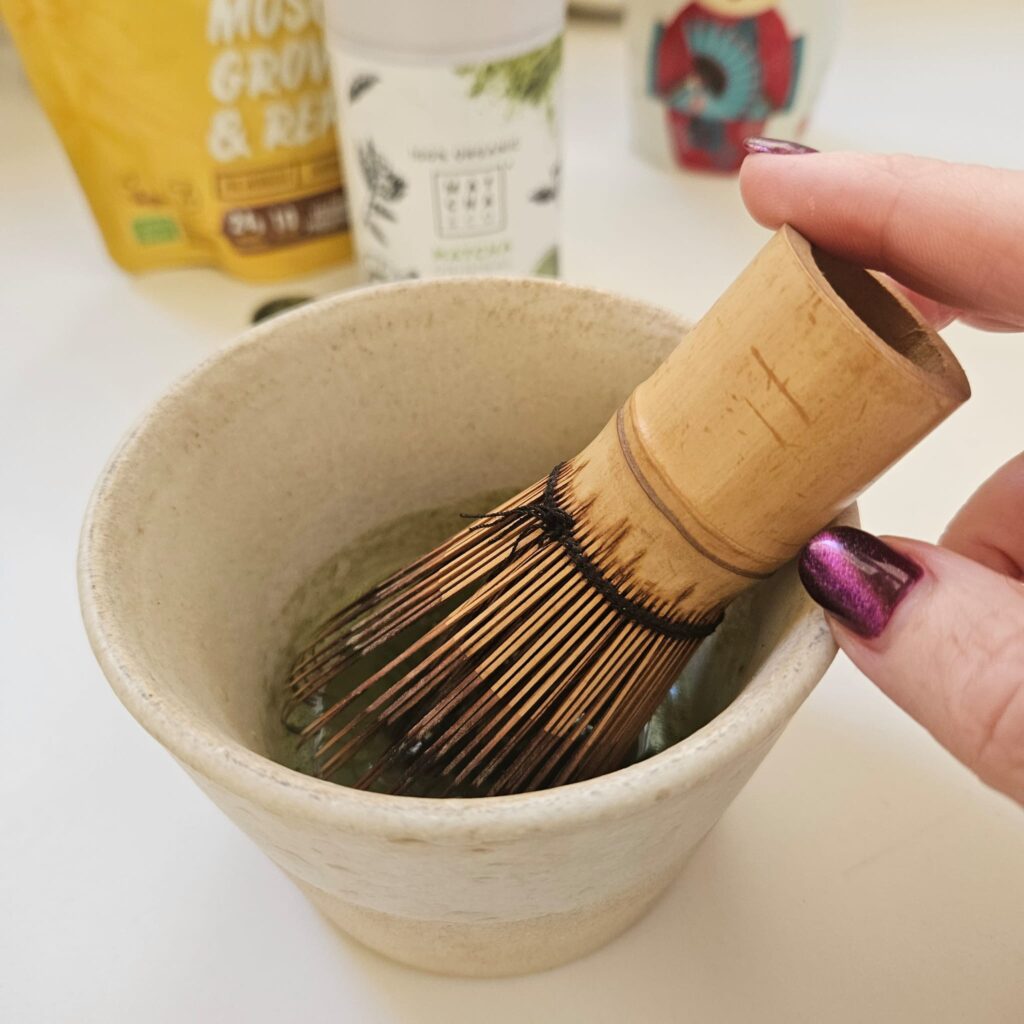
Matcha Tea 🍵 is a high-grade green tea ground into powdered form. The green tea powder is whisked into hot water, instead of steeped, to form a frothy drink.
I prepare what I call “the runner’s matcha tea version” 🏃♀️+🍵, because I add “powered vegan protein” into the mix. I mix the protein with the green tea and add water at 70 degrees. Then I add soya milk.
But once in Japan I realised that their love of matcha is even higher than mine and can be seen in Matcha candies, pastries, biscuits, ice creams, beverages and even kit-kats!

I also found a “Matcha Sweets Factory” shop next to the Asakusa Kannon Senso-ji temple!

The benefits of matcha tea for runners are many!
Increased Energy and Endurance: Matcha contains caffeine, which can provide a natural energy boost. Unlike coffee, matcha also contains L-theanine, an amino acid that can enhance focus and prevent the jitters often associated with caffeine consumption. This combination of caffeine and L-theanine can help runners sustain energy levels and improve endurance during long runs.
Improved Focus and Concentration: The L-theanine in matcha has been shown to promote relaxation and mental clarity, which can be beneficial for runners during training sessions and races. Enhanced focus can help runners maintain proper form, pace themselves effectively, and stay mentally sharp throughout their run.
Antioxidant Properties: Matcha is rich in catechins, a type of antioxidant that helps protect cells from damage caused by free radicals. These antioxidants may reduce inflammation and oxidative stress, which can help speed up recovery time after intense workouts and minimize muscle soreness for runners.

Support for Immune Function: The antioxidants found in matcha, including epigallocatechin gallate (EGCG), may also support immune function by combating oxidative stress and reducing inflammation. This can be particularly beneficial for runners, as intense training can sometimes suppress the immune system, making athletes more susceptible to illness.
So, while having lunch in the restaurant Asakura View Mushashi and enjoying its views, I decided to taste an assortment of matcha desserts 😉:

Finally, if we talk about matcha tea, I need to mention the Japanese Traditional Tea Ceremony.
The now famous ceremony consists in preparing, presenting and sipping the team in a meditative state, “being present”.
In this article there is a selection of 7 places in Tokyo where you can enjoy it the traditional way, served by instructors, professors or geishas, and even in English.
Protein Recovery in Omoide Yokocho: Famous for their Yakitori 🍢!
If you are in Shinjuku, do not miss the alleys called “Omoide Yokocho“. They are crowded, bustling with life and the steam from the grills were yakitori are cooked.

There are hundreds of tiny restaurants: specially motsuyakiya (broiled offal restaurants) and yakitoriya (chicken skewer restaurants)
In this article by “Japan Experience” about it, Shinjuku is described as such:
"... giant high rise buildings and pedestrian bridges dominate the city scape. Huge video screens covering entire building fronts noisily blast out the latest in J-Pop and rock while legions of businessmen in suits hurry by. For the casual (foreign) visitor, the school girls in uniform and colorful characters of all stripes may complete the image of Shinjuku as a futuristic manga fantasy come to life."
And funnily enough this was exactly our experience. Not only in the streets but even inside the restaurant we chose. We ate in the company of videos of J-Pop and very colourful Japanese were eating next to us.

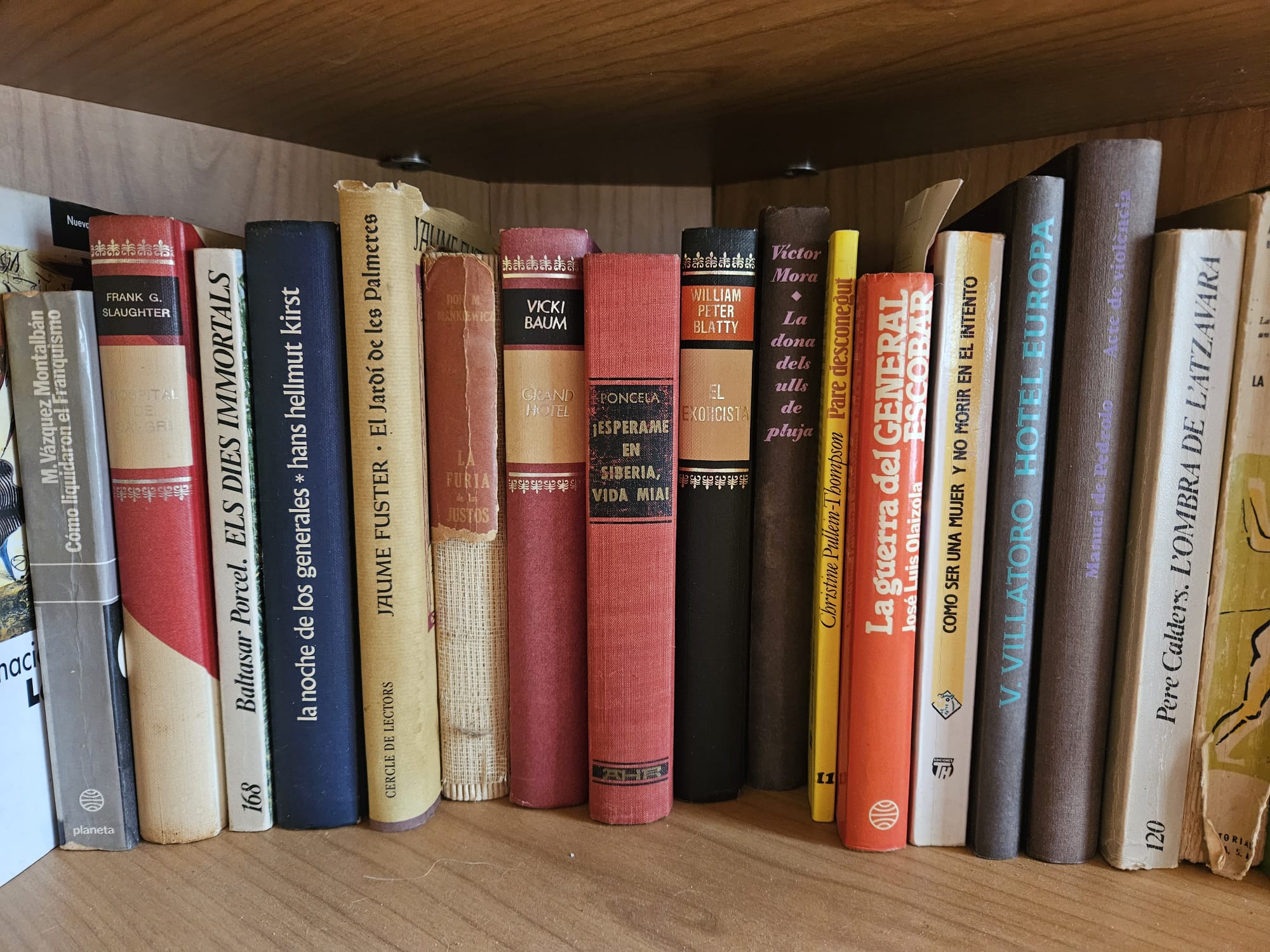
One book
“Shogun”, by James Clavell.
When, as a teenager, I first read “Shogun”, the epic story about an Englishman stranded in 1600s Japan, I was hooked. I absolutely loved it! After this, I read all of the books of Clavell’s Asian Saga, but “Shogun” remains my favourite.
I have read the novel several times over (and again before this trip), both in Spanish and in English.
And, a week before travelling, I re-watched the 1980’s series starrring Richard Chamberlain (who, by the way, was a track athlete when young 🏃) and the legendary Toshirô Mifune.

I am always impressed with how James Clavell masterfully describes the culture differences between Europeans and Japanese, and all the intrigues until the great character of Toranaga becomes… Shogun!. Yoshi Toranaga is a character based on a Tokugawa Ieyasu.

Summary: A bold English adventurer. An invincible Japanese warlord. A beautiful woman torn between two ways of life. All brought together in an extraordinary saga aflame with passion, conflict, ambition, and the struggle for power.
Here is the world-famous novel of Japan that is the earliest book in James Clavell’s masterly Asian saga. Set in the year 1600, it tells the story of a bold English pilot whose ship was blown ashore in Japan, where he encountered two people who were to change his life: a warlord with his own quest for power, and a beautiful interpreter torn between two ways of life and two ways of love.
“Las huellas del Samurai”: or how a town in Andalucia is linked to a legendary Samurai

Btw, I found a very interesting documentary in Netflix, in Spanish, called “Las huellas del Samurai”, about how come in a town in Andalucia, Coria del Rio, there is a large population of people with the surname “Japon” (Japan in Spanish)…
This is linked to the epic first Japansese diplomatic expedition to a Western nation, in 1614, leaded by the samurari Hasekura Tsunenaga.

To know more…
The famous Japanese writer Haruki Murakami is a well known runner, and his books are famous amongst the runner community and literature junkies alike.
Specially the book that he wrote about…. running:
What I talk about when I talk about running

Summary: In 1982, having sold his jazz bar to devote himself to writing, Murakami began running to keep fit. A year later, he’d completed a solo course from Athens to Marathon, and now, after dozens of such races, he reflects upon the influence the sport has had on his life and on his writing.
Equal parts travelogue, training log and reminiscence, this revealing memoir covers his four-month preparation for the 2005 New York City Marathon and settings ranging from Tokyo’s Jingu Gaien gardens, where he once shared the course with an Olympian, to the Charles River in Boston.
In general, I find Japanese literature fascinating, and amongst the books I have enjoyed, I highlight the following:
“The temple of the Golden Pavillion” by Yukio Mishima
Amazingly well written and even poetic, although a little bit dense at some points, Mishima takes you down the road of obsession with dramatic consequences.

Summary: Because of the boyhood trauma of seeing his mother make love to another man in the presence of his dying father, Mizoguchi becomes a hopeless stutterer. Taunted by his schoolmates, he feels utterly alone and develops a childhood fascination with Kyoto’s famous Golden Temple. While an acolyte at the temple, he fixates on the structure’s aesthetic perfection and it becomes his one and only object of desire. But as Mizoguchi begins to perceive flaws in the temple, he determines that the only true path to beauty lies in an act of horrific violence.
Based on a real incident that occurred in 1950, The Temple of the Golden Pavilion brilliantly portrays the passions and agonies of a young man in postwar Japan, bringing to the subject the erotic imagination and instinct for the dramatic moment that marked Mishima as one of the towering makers of modern fiction.
“Thousand cranes” by Yasunari Kawabata
I really like the works of Yasunari Kawabata, born in Osaka in 1899; specially “Thousand cranes“, which is an ode to the famous Japanese Tea Ceremony, which I have written about earlier.
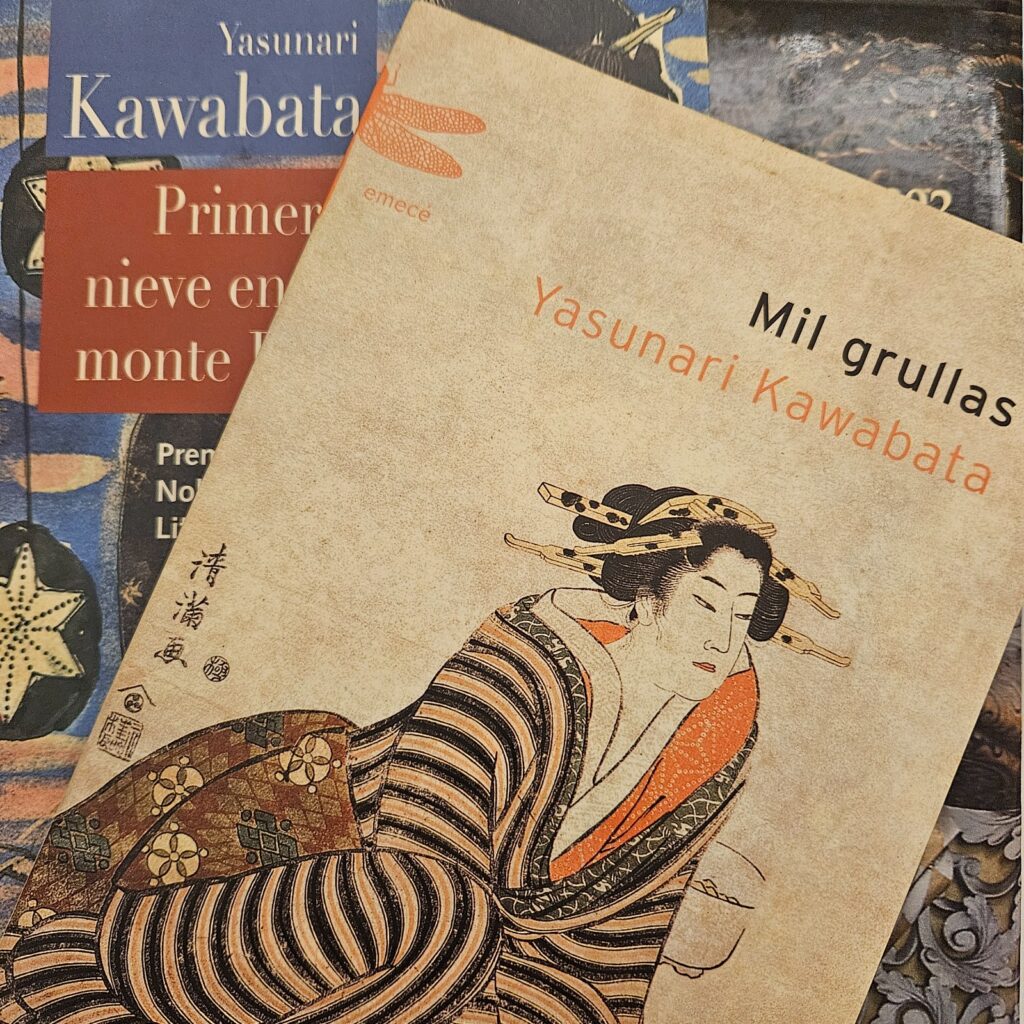
Summary: Kikuji has been invited to a tea ceremony by a mistress of his dead father. He is shocked to find there the mistress’s rival and successor, Mrs. Ota, and that the ceremony has been awkwardly arranged for him to meet his potential future bride. But he is most shocked to be drawn into a relationship with Mrs. Ota – a relationship that will bring only suffering and destruction to all of them.
